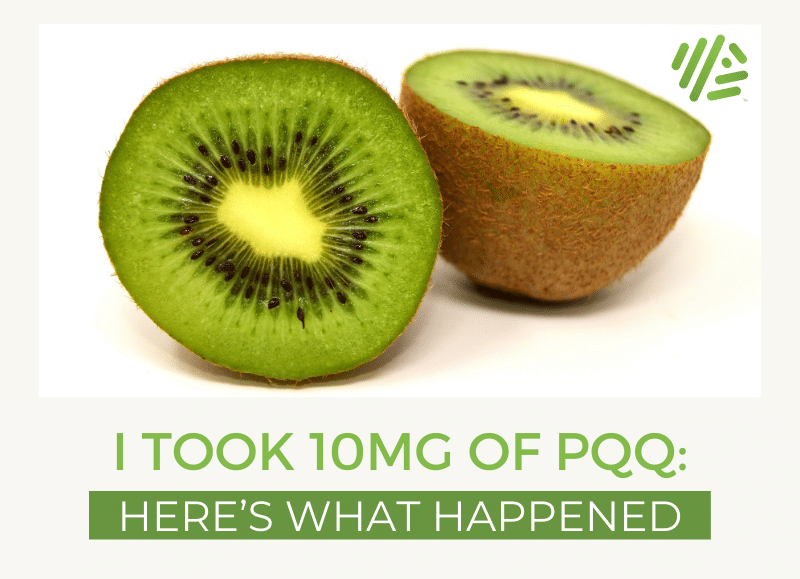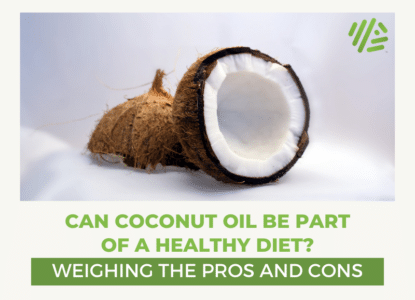I Took 10mg of PQQ: Here’s What Happened

Contents
This post was co-written with Gene Food founder, John O’Connor.
Part of my job here at Gene Food is playing guinea pig with new supplements. As I’d yet to try the much heralded pyrroloquinoline quinone (PQQ), I figured it was past time to give this ostensible mitochondria booster a go.
Because PQQ is a potent supplement it is offered in low doses, hence my rather small 10mg experiments.
I first took PQQ alongside 1,000 mg of vitamin C. The Tesla supplement alongside the horse and buggy supplement, why not?
After taking a day off after the first dose, I took my second dose of PQQ with 200mg of Ubiquinol as it is supposed to improve PQQ bioavailability. Since those initial experiments, I almost never take PQQ because I never know how it’s going to hit me and I noticed diminishing returns the more I took.
With my first dose, I felt an impact right away with the energy boosts lasting for an entire day. However, as I will discuss, my concern is that PQQ may cause drops in energy in the days after supplementing for some people. In a few cases, I did notice an “afternoon lull” when taking PQQ. After a few hours of significant energy benefits, I’d hit a valley for a few hours where I almost wanted to take a nap, but the episodes pass and I usually close out the day on a high note. Interestingly, a girlfriend of mine took a dose of PQQ and it instantly calmed her and put her to sleep.
Before I delve more into my experience, some background on PQQ.
The Science of PQQ
PQQ is all the rage in the functional health world as a mitochondrial enhancer. However, PQQ is also a new supplement and we don’t have any real data on how it affects people long term, so I’ve brought in the heavy guns, AKA Aaron, to help breakdown the science on PQQ.
Put simply, PQQ is a redox cofactor… which isn’t particularly helpful I know, so let me elaborate.
Let’s break that statement down some; redox is the shorthand for reduction-oxidation, these balanced reactions involve the reduction of one (or many) molecule and the oxidation of another.
Importantly, these reactions also involve the swapping of electrons between molecules, which you can read as a means of transferring energy.
These reactions are absolutely fundamental to life. Think photosynthesis which involves the reduction of carbon dioxide into sugars in plants (essentially transferring energy from the sun to the plant), and the reactions which occur within our mitochondria to generate energy by breaking down these sugars (transferring energy from the plant to us). I won’t go into much detail about these reactions as they are rather long and complex containing many different steps, with each one of these steps driven by a particular enzyme.
Enzymes function to speed up or facilitate natural reactions and they often require a cofactor to function. Cofactors are small molecules, often metal ions, but sometimes more complex structures which interact with an enzyme and allow it to function optimally. Historically, there were thought to be just two redox cofactors, flavin (from riboflavin or vitamin B2) and nicotinamide which are both used by our mitochondria to generate energy.
PQQ is a novel third redox cofactor which is found in foods like kiwi fruit, green tea, green peppers and herbs such as parsley, and the fermented soy product nattō.1
It is unclear whether we can synthesize PQQ ourselves, with some suggesting that we source it solely from our diet, others arguing that is produced by bacteria living in our gut and yet others claiming we produce a low level ourselves.
Health Benefits of PQQ
As John alluded to, the current data surrounding the use of PQQ in humans is rather limited, with just two published clinical trials.23
Reduction in LDL-C and Improved Heart Health
Both these studies utilized a PQQ disodium salt (sold as BioPQQ) at a dose of 20 mg/day (pretty big dose). In the first study the authors report on a reduction in LDL cholesterol levels in the blood, while in the latter they report on improved cognitive function.
As mentioned in this post on phospholipids and curcumin, elevated TMAO has been linked to heart disease, with a New England Journal of Medicine Study finding that both L-carnitine and lecithins are metabolized by our gut bacteria into TMAO.4
In a tiny study of 5 men and 5 women, PQQ supplementation caused a reduction in a number of different inflammatory markers, including TMAO:
PQQ supplementation resulted in significant decreases in the levels of plasma C-reactive protein, IL-6 and urinary methylated amines such as trimethylamine N-oxide, and changes in urinary metabolites consistent with enhanced mitochondria-related functions. The data are among the first to link systemic effects of PQQ in animals to corresponding effects in humans.
Given its role as a redox cofactor, and that we know how energy intensive powering the brain is, we can hypothesize that PQQ is achieving this by stimulating mitochondrial action, however there are no human studies confirming this effect.
PQQ and Mitochondria Health
There is however a paper which did demonstrate a positive effect on mitochondrial efficiency in broiler chickens of all things.5
It’s therefore difficult to determine a science grade for PQQ, given its promising results, but lack of human evidence, a rating of six, feels appropriate. However, this is definitely one to watch as numerous studies are likely underway which may result in an improved rating.
I’ll hand back over to John now so he can report on how he felt about supplementing.
How PQQ Made Me Feel
The first time I took it, it took about 45 minutes for me to feel the effect of PQQ, which was pleasant. The main difference I noticed was in the quality of my focus.
Improved focus
I felt a stronger, more sustained focus, and a greater interest in the task I was involved with while I was doing it. As I was in line for some white tea at a local coffee shop, the words “sledgehammer focus” came to mind. For the sake of this blog post, let’s say that sledgehammer focus is the ability to drop weight behind your work and get after a task with sustained quality.
For a multi tasker like myself, one of the hallmarks of my less productive days is reduced focus. I get on my phone, start checking email, and bam, I am out of deep work mode and sprinting on the digital hamster wheel: social media to email, back to the NY Times, Venmo, Instagram.
You get the idea.
On my best days, I am able to do the deep work I want to do and stay there to finish off the details with a Bhagavad Gita, Karma Yogesque detachment (your right is to action alone, never its fruits). Creativity was enhanced, focus was enhanced, and I would say there was an almost “happy hallucination” like effect as well.
Improved mood
PQQ is also supposed to improve mood. I noticed a subtle, but tangible uptick in mood and outlook the first time I took PQQ. As I continued to experiment with PQQ, especially during the times I took a ubiquinol and PQQ blend (which has only been on a couple occasions) the mood boost was even more tangible and lasted into the next day.
Sustained energy
On the days I took PQQ, I felt a noticeable and significant uptick in energy levels.
PQQ and Exercise
I have mixed emotions when it comes to mitochondrial enhancing supplements and exercise. On the one hand, it’s nice to get a boost of energy that can lead to better performance. On the other hand, sometimes the “pop” that these supplements give is too much and I’d prefer to be working out without the help of a stimulant. PQQ gives me an energy boost for an entire day, albeit with an occasional afternoon lull, but I did find that doing a workout after having taken PQQ was a bit much, I almost felt too energized.
PQQ and Ubiquinol
The second time I took PQQ, it was alongside Ubiquinol, which is supposed to increase bioavailability of PQQ, but I felt that the effect was weaker with the Ubiquinol. However, this may have had nothing to do with the Ubiquinol as many people have reported diminishing returns the longer they take PQQ. The consensus is that it needs to be cycled. And as I mention above, when I took ubiquinol and PQQ at later times, I did notice a strong effect.
PQQ Side Effects
As I mentioned at the outset of the post, both days I took PQQ, I must say that I felt amazing, however, after the second dose I noticed an afternoon energy crash.
Even Joe Cohen at Self Hacked, which is a well researched, albeit very pro supplement blog, has suggested cycling PQQ, that it is not for everyday use.
Discussion boards on Dave Asprey’s PQQ product Unfair Advantage, mention decreased efficacy the longer PQQ is taken. A personal trainer friend of mine noticed chest pains after taking PQQ.
Closing thoughts
We don’t have the full mechanism yet behind PQQ, and there have been very little in the way of human studies. Evidence of cardiovascular benefits are particularly exciting to me, so I will keep experimenting in small doses, even though I may ultimately shelve PQQ if it causes energy troughs as it seems to after initial uses.
I don’t think this is an everyday supplement for most people.
With the rise of importance of serum TMAO levels as a marker for heart disease, I’d be fascinated to see a study that looked at the levels of TMAO in those taking PQQ vs. a placebo group.
PQQ Supplement FAQ
PQQ is often paired with the Ubiquinol, the more bioavailable form of CoQ10, because research indicates that PQQ is more bioavailable when paired with Ubiquinol.
PQQ is a novel third redox cofactor which is found in foods like kiwi fruit, green tea, green peppers and herbs such as parsley, and the fermented soy product nattō.



I am an almost 70 year old retired art teacher. My daughter is a 40 year old cardiac anesthesiologist. When we drink one cup of coffee not decaf we have similar reactions. When we drink 2 cups of coffee call me she is energized and ready to go when I drink 2 cups of coffee I am ready for a nap. Maybe there’s some connection to PQQ.
I have chronic fatigue / myalgic Encephalomyelitis and there seems to be some distinct issues with mito dysfunction. I have periodic energy bursts with things like d-ribose, Nicotinamide riboside, Niacin, MitoQ and I’m trying PQQ.
I love a good placebo too 🙂
I take one PQQ every week and this “seems” to give me the kick I need to have mental focus ( brain fog was so bad I had to stop working)
Do we have any more research on PQQ since you wrote this ?
James, thanks for the comment. I haven’t seen anything new on PQQ, but will have my research team look into it.
I take a large variety of different supplements, so it’s hard to pinpoint effects of one over another, but I’ve recently had a bout of insomnia and it seems to have started around the time I recently picked up a bottle of PQQ supplements. I’ve about run out and will see what happens when I stop using it.
I am a 67 yo retired from a 47 years of working/managing clinical labs. I’m a healthy looking slim, workaholic, high energy, high endurance, long distance runner, health nut who (in my 50’s) developed t2 diabetes, arthritic symptoms, arthersclerosis, high chol & LDL, sleep apnea and cognitive decline. Dr. Discovered that I was homozygous APO E4. I have concentrated on high fiber, low fat (except EV olive oil) low carb diet high in antioxidants (CQ10/PQQ included). Results have been fantastic. I suggests trying a suppliment for a month. If no improvement drop it. If improvement, drop it for a week to see if you revert then start up again. You’ll have to figure it out yourself. Find out what works for you! Most suppliments are hooey. FDA is corrupt & counterproductive. Few Drs. (some do) know or care about anything about suppliments.
Taking vitamin c allows less antioxidant activity from your body’s coq10 stores enabling more energy production in the cells
March–2019—-I was diagnosed with CKD (chronic kidney didease) . I acquired it from taking Nexium –Prilosec. It goes through 5 stsges to DIALYSIS & takes your life—if your young you can get a transplsng. KAL brand PQQ—5MG. (I took for 2 months) My kidney counts –IMPROVED by 20 pts.!—-I did nothing else different—-THIS GENE FOOD——I believe IMPROVED MY CHRONIC KIDNEY DISEASE!!!——I am.comtinuing on it—–& will up the dose if necessary.